#Robotics kit for beginners
Explore tagged Tumblr posts
Text

Home Automation Electronics Kit
Discover the fascinating world of smart home technology with this interactive learning kit, designed to spark curiosity in young minds. Combining the versatile ESP32 board with engaging story-based activities, this kit immerses children in the exciting world of home automation. Packed with a variety of sensor modules and programming tools, it allows young learners to build, experiment, and protect a smart home while honing essential STEM skills. Perfect for nurturing creativity and problem-solving abilities, this hands-on kit offers a fun and accessible introduction to the future of technology. Ready to dive in? Click the link to learn more and make your purchase!
#Home Automation Electronics Kit#Python and AI learning kit#Raspberry Pi AI kit#AI-powered electronics projects#AI learning kits#Robotics kit for beginners#Build your own AI assistant#DIY AI learning kit#Machine learning for beginners#Generative AI learning projects
0 notes
Text
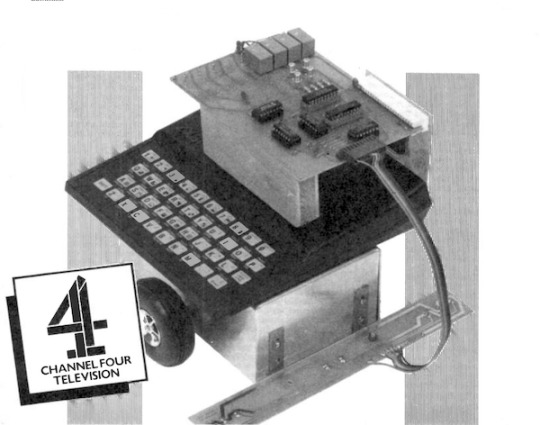

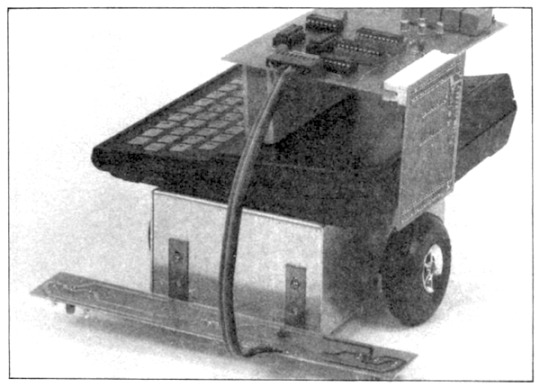
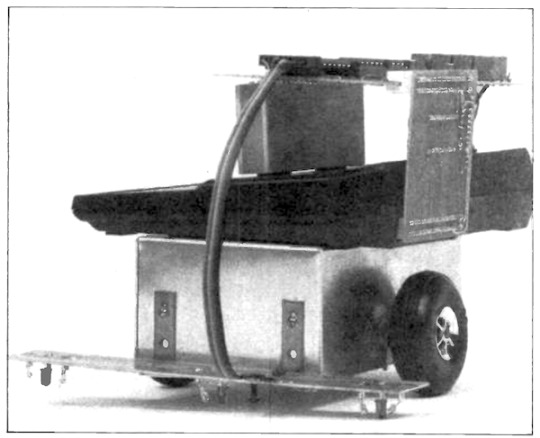


Trundle (1985) by Eddie Forrester & Robin Moorshead, Ilford County High School, UK. Full construction details of the Trundle robot feature in Channel 4's "4 Computer Buffs" every Monday at 5 p.m. for six weeks, starting 11th February 1985. "The Trundle package consists of an interface and memory expansion board for the ZX81 and the extra pieces necessary to make a ZX81 based 'Trundle' robot. The system is supplied in kit form with a comprehensive set of instructions. The interface was designed with the aim of encouraging participation in robotics and allowing other applications of interfacing. This exciting field is often avoided by both software writers as being too complicated electronically and by electronics enthusiasts as being too complicated from the programming angle. However, these fears are not justified. An interfacing project may be as hardware or software intensive as the designer wishes. A lack of skill in the hardware field can usually be made good with an extra piece of software and vice-versa. Trundle was designed to bring the beginner up to a reasonable level of competence with both a computer keyboard and a soldering-iron." – Trundle The Channel Four Robot, The Inside Story By Eddie Forrester & Robin Moorshead, The Maplin 'Electronics' Magazine, March to May 1985 (p16).
20 notes
·
View notes
Text

HGWFM 1/144 Gundam Lfrith
Gundam Lfrith!!! This is the final kit I wanted for my Witch From Mercury collection. Overall, I think most of the kits I've collected have been from this series, and I've really enjoyed all of them. The WFM line has really innovated in terms of what gunpla can be and it's a really nice thing to see Bandai doing.
I've actually already built a Lfrith kit, which you can see here. I customized it into a Hatsune Miku robot, but the build process was really enjoyable and I've wanted a non-customized one just to display for some time.
Overall, this kit has some of the best HG colour separation I've ever seen in a gunpla kit, with only some grey on the feet required to achieve screen accuracy, and minimal colour correction stickers.
Lfrith's GUND-bits can be stored on the rather bulky looking backpack unit, alongside the beam sabers and beam rifle. Two bits actually connect to the rifle to increase its range.


Like the Aerial's, the Lfrith's beam rifle also has a large beam blade mode, achieved using a trans-blue effect piece.
A nice thing about this kit is that it only has a single Permet effect area, with both a printed and sticker option for it. This means you can actually swap out the chest piece to display it in both active and deactive mode!


To celebrate Pride this year I've painted the GUND-but shield in the trans pride flag colours, which match really nicely with the kit's existing color scheme.
Overall this is a really beginner friendly kit and I definitely recommend it for any gunpla collector.
#gunpla#my gunpla#hg gunpla#plamo#model building#gundam#mobile suit gundam#mobile suit gundam the witch from mercury#witch from mercury#Lfrith#gundam lfrith#ericht samaya#prospera mercury#transgender#trans pride#pride#pride month
28 notes
·
View notes
Text
@glitchexmachina wants a starter.
“Tyson ya gotta check this out!” Harley yelled as she barged into the workroom looking for him. She said hello to every machine she passed, just in case they were all sentient. She was never sure around Tyson’s robots.
Harley grinned and held out a small robotic toy frog. It wasn’t nearly as advanced as some of the things Harley had seen Tyson make, but she was still proud of it. “I bought this robot kit thinkin’ it would be a cool Christmas present for ya but then I realized how… Beginner it was.. So I made it myself! You can even teach it with your voice. Watch this!” She set the toy on the table and leaned in with a grin. “Jump!” Harley held up a finger for Tyson to be patient as she waited for the toy to move. “Huh.. Maybe I didn’t do the voice thingy right..”
9 notes
·
View notes
Text
Ultimate Guide to Choosing the Best Gifts for Kids

When it comes to finding the perfect gifts for kids, the options can feel endless—and a bit overwhelming. From educational toys and tech gadgets to creative crafts and outdoor gear, the best kids’ gifts strike a balance between fun and functional, entertaining and enriching.
Whether you're shopping for a birthday, holiday, or a special milestone, this guide will help you discover the top gifts for kids of all ages in 2025. We've compiled ideas that cater to various interests and budgets, so you can find a present that truly brings joy.
Why Choosing the Right Gift for Kids Matters?
Kids are constantly learning, growing, and exploring the world around them. The right gift can:
Encourage creativity and problem-solving
Support physical or mental development
Foster interests and passions
Provide entertainment and bonding time with family or friends
When choosing gifts for kids, consider their age, personality, and hobbies. Are they into building things? Love reading? Obsessed with science or sports? The best gifts are thoughtful and age-appropriate.
Top Gifts for Kids by Age Group
1. Gifts for Toddlers (Ages 1–3)
For toddlers, the best gifts are safe, stimulating, and help with motor skill development.
Stacking Toys and Building Blocks – Encourage hand-eye coordination and imaginative play.
Ride-On Toys – Great for physical activity and balance.
Interactive Learning Toys – Toys that sing, talk, or light up can help toddlers learn numbers, letters, and shapes.
Soft Books – Durable and colorful books make reading fun from an early age.
2. Gifts for Preschoolers (Ages 4–6)
Preschoolers love to explore, pretend, and learn new things.
Arts and Crafts Kits – Help kids develop fine motor skills and creativity.
Educational Games – Look for options that teach phonics, math, or problem-solving in a fun way.
Play Kitchens or Tool Sets – These promote role-playing and imagination.
Puzzles – Great for critical thinking and patience.
3. Gifts for School-Aged Kids (Ages 7–10)
Kids in this age group begin to develop specific interests and skills.
STEM Toys – Think coding robots, science kits, and engineering sets.
Board Games – Choose games suitable for their age that encourage strategic thinking.
Sports Equipment – A soccer ball, basketball hoop, or skateboard can keep kids active.
Books – Series like Dog Man, Harry Potter, or The Treehouse Books are hits with this age group.
4. Gifts for Tweens (Ages 11–13)
Tweens are starting to develop independence and stronger opinions.
Tech Gadgets – Smartwatches for kids, beginner-friendly tablets, or headphones.
DIY Craft Kits – Jewelry making, painting, or DIY slime kits are very popular.
Subscription Boxes – Monthly boxes for science, art, or reading keep the excitement going.
Outdoor Gear – Bikes, scooters, or even roller skates encourage activity and fun.
Trending Gifts for Kids in 2025
Looking for what's hot this year? Here are some trending gifts for kids in 2025:
Augmented Reality Learning Toys – Merging physical and digital play for interactive learning experiences.
Eco-Friendly Toys – Wooden toys, recycled materials, and sustainable packaging are becoming more popular among parents.
Personalized Gifts – Custom storybooks, name puzzles, or backpacks add a personal touch kids love.
Virtual Reality Headsets for Kids – Safe and age-appropriate VR experiences for gaming and learning.
Tips for Choosing the Perfect Gift
Consider Their Interests – Whether they love dinosaurs, art, space, or animals, pick something that aligns with what excites them.
Think About Longevity – Choose gifts that kids can grow into or use for a long time.
Encourage Learning – Many educational toys are so fun, kids won’t even realize they’re learning.
Ask Parents – When in doubt, ask the parents (especially for younger kids) about preferences, restrictions, or needs.
Budget-Friendly Gift Ideas
Not every great gift needs to cost a fortune. Here are some thoughtful and affordable gifts for kids under $25:
Coloring books and crayons
Card games like Uno or Go Fish
Mini puzzles or travel games
DIY science or art kits
Books or comic collections
Final Thoughts
Finding the right gifts for kids doesn’t have to be stressful. Whether you’re looking for something educational, interactive, or just plain fun, the best gifts are those that match the child's personality and stage of development.
Remember, the goal is to bring a smile to their face and spark their imagination. With the ideas above, you're sure to find a gift that does just that.
2 notes
·
View notes
Text
me: hey youtube, i'm really into gunpla lately, i like watching videos about gunpla kits. i have no privacy from you, you know all this already. so what's...
youtube: vinyl anime girl figurines in bikinis, you wanted?
me: no, that's not... gunpla. i like gundam plastic model kits. i wanna admire all the little detail in kits i don't have and learn some modelling techniques to apply to the ones i do.
youtube: ahh, gotcha. here's ww2 nazi germany panzer tank model kit reviews.
me: no! gundams! model kits of fictional giant robots! tiny 1/144 scale model kits of fictional giant 20m tall robots with laser swords they hold in their hands and put in cool poses! fictional. robot. kits.
youtube: this nazi half-track truck is considered one of the best 1/32 scale model kits for beginners, it comes with a full mechanised infantry support unit to paint, with accurate uniforms.
me: no.
youtube: best imperial japanese army fighter aircraft model kit 2023?
me: robots! fictional. robots.
youtube: ahh, best imperial japanese navy battleship model kit 2023.
me: listen, you...
youtube: a-10 warthog desert storm camouflage custom painted model kit!
me: STOP! i don't want vehicles of war! look i get it, gundam is a franchise about the horrors of war and we all missed the point in favour of 'wow cool robot' or lately 'omg cool yuri private school romance' or whatever, but it's not real. they're not real machines. it's not a real war, it's fiction. i can build these little guys as a distraction from the impending war here, from the existing wars, from the horrors of wars burned into my brain by live television news, i can love the zaku and zgok without conflating the republic of zeon with real world military superpowers seeking to dominate the globe and becoming a fascist fetishist because of anime robots.... i don't want to watch creepy old men salivate over scale model sculpted detail in planes with gattling guns that mowed down civilians, real human civilians, in real life wars. i want to watch energetic irish homosexuals rank the single-joined elbow posability of a bright red mech with a laser axe that'd be larger than a building, if it were real, which it is not, because these are toys for playing with, not historically accurate recreations of actually extant machines of horror and death. there is a difference! surely there is some confluence of keywords and user engagement metrics that can elicit an echo of understanding the difference in your unthinking algorithmic fever dream of signals????
youtube: ...
me: *panting with rage*
youtube: .....balloon titty anime bikini girl with the sculpted face of a scared crying child? it's a model kit!
19 notes
·
View notes
Text
Gear Up! A Beginner's Guide to Learning Robotics
Hey Tech Enthusiasts!
Are you fascinated by robots and want to dive into the world of robotics? Learning robotics can seem daunting, but with the right resources and mindset, you can get started!
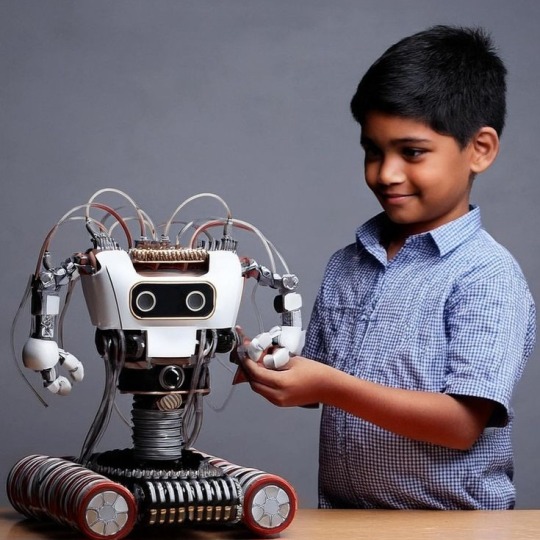
Step 1: Understand the Basics
- Familiarize yourself with programming languages like C++, Python, or Java
- Learn about electronics, circuitry, and microcontrollers (e.g., Arduino, Raspberry Pi)
- Get a grasp on mechanical concepts (e.g., kinematics, dynamics)
Step 2: Choose Your Path
- Robotics kits (e.g., Lego Mindstorms, Makeblock)
- Online courses (e.g., Coursera, edX, Udemy)
- Books (e.g., "Robotics, Vision & Control" by Peter Corke)
- Join online communities (e.g., Reddit's r/robotics, r/learnprogramming)
*Step 3: Practice & Build*
- Start with simple projects (e.g., line follower, robotic arm)
- Experiment with sensors, actuators, and control systems
- Join robotics competitions or hackathons
Step 4: Network & Learn from Others
- Attend robotics conferences, meetups, or workshops
- Collaborate with fellow robotics enthusiasts
- Participate in online forums
Resources:
- Code.org's Robotics Course
- Robotics Academy
- Robot Operating System (ROS)
Inspiration:
- Boston Dynamics' robots
- NASA's Robotics Alliance Project
- Robot Wars
Conclusion:
Learning robotics takes time, patience, and dedication. Stay curious, persistent, and creative!
What's your favorite robotics project or resource? Share in the comments!
[Reblog if you're interested in robotics!]
3 notes
·
View notes
Text
5 Arduino Courses for Beginners
Robotics, automation, and do-it-yourself electronics projects have all been transformed by Arduino, an open-source electronics platform. Entering the world of Arduino may seem intimidating to novices, but the correct course may make learning easier and more fun.
Arduino Step-by-Step: Getting Started (Udemy)
This extensive Udemy course is designed for complete novices. It provides an overview of Arduino's fundamentals, describing how the platform functions and assisting students with easy tasks like using sensors and manipulating LEDs.
Key Highlights:
thorough explanations for novices.
practical projects with practical uses.
instructions for configuring and debugging your Arduino board.
Introduction to Arduino (Coursera)
The main objective of this course is to introduce Arduino programming with the Arduino IDE. It goes over the fundamentals of circuits, programming, and connecting various parts, such as motors and sensors.
Key Highlights:
instructed by academics from universities.
access to a certificate of completion and graded assignments.
Concepts are explained in length but in a beginner-friendly manner.
Arduino for Absolute Beginners (Skillshare)
For those who want a quick introduction to Arduino, this brief project-based course is perfect. You'll discover how to configure and program your Arduino board to produce interactive projects.
Key Highlights:
teachings in bite-sized chunks for speedy learning.
simple projects for beginners, such as sound sensors and traffic light simulations.
Peer support and community conversations.
Exploring Arduino: Tools and Techniques for Engineering Wizardry (LinkedIn Learning)
This course delves deeply into Arduino programming and hardware integration, drawing inspiration from Jeremy Blum's well-known book. It is intended to provide you with the skills and resources you need to produce complex projects.
Key Highlights:
advice on creating unique circuits.
combining displays, motors, and sensors.
Code optimization and debugging best practices.
Arduino Programming and Hardware Fundamentals with Hackster (EdX)
This course, which is being offered in partnership with Hackster.io, covers the basics of Arduino hardware and programming. You may experiment with real-world applications because it is project-based.
Key Highlights:
Course materials are freely accessible (certification is optional).
extensive robotics and Internet of Things projects.
interaction with teachers and other students in the community.
Arduino is a great place to start if you want to construct a robot, make a smart home gadget, or just pick up a new skill. The aforementioned courses accommodate a variety of learning preferences and speeds, so every novice can discover the ideal fit. Select a course, acquire an Arduino starter kit, and set out on an exciting adventure into programming and electronics!
To know more, click here.
2 notes
·
View notes
Text
The best kids gift ideas for Christmas 2023
The holiday season is upon us, and it's that time of year when the joy of giving brings smiles to our little ones' faces. Finding the perfect gift for kids can be a delightful yet challenging task. To help ease the stress of holiday shopping, here's a curated list of the best kids' gift ideas for Christmas 2023 that will spark joy and imagination:

STEM Toys
STEM toys engage children in science, technology, engineering, and math concepts through play. Look for kits that offer hands-on learning experiences like robotics, coding, or science experiments. These toys are both educational and entertaining, making learning a delight.
Outdoor Toys
Encouraging outdoor play is vital for kids' physical health and overall development. Consider gifting kids scooters, bicycles, or roller skates to inspire adventure and exercise while allowing them to explore the outdoors.
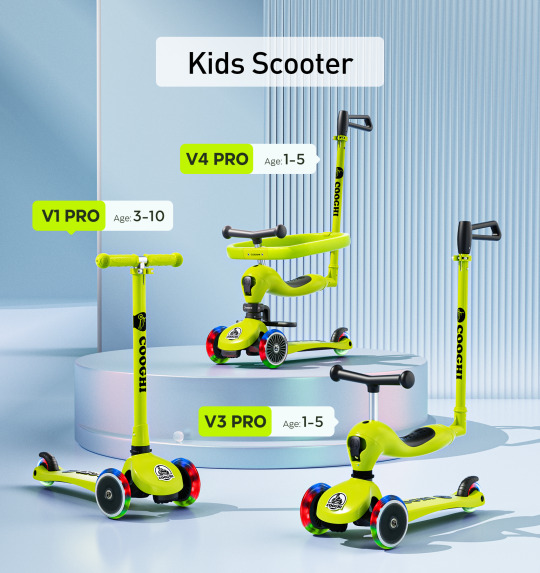
Art Supplies
For the budding Picassos and Van Goghs, art supplies are a gateway to self-expression. Art sets, sketchbooks, paints, and different mediums can nurture their creativity and provide a means to express their imagination freely.

Board Games and Puzzles
Board games and puzzles are timeless classics that promote critical thinking, strategy, and social interaction. Choose games suitable for their age group and interests, fostering bonding moments and cognitive development.
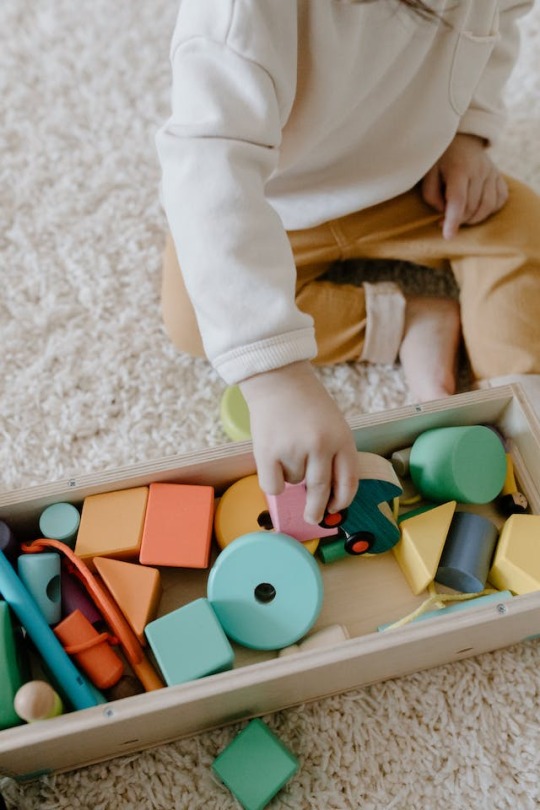
Musical Instruments
Introducing kids to musical instruments cultivates a lifelong appreciation for music. Whether it's a beginner's keyboard, a mini drum set, or a ukulele, these gifts can spark a passion for melody and rhythm.

Dolls
Why it’s great: Dolls offer companionship and imaginative play. If they're fans of anime, gifting their favorite characters in doll form can inspire storytelling and imaginative adventures.

Gardening Tool Kit
A gardening tool kit encourages kids to explore nature and develop a green thumb. It’s an interactive way to teach responsibility, patience, and the wonders of watching something grow.
This Christmas, choosing the perfect gift involves understanding a child's interests, fostering their development, and sparking joy. Whether it’s igniting their curiosity with STEM toys, encouraging outdoor exploration, nurturing creativity through art, fostering social skills with games, or introducing new hobbies, the best gifts are those that inspire and captivate young hearts and minds. Embrace the joy of giving and watch as these gifts light up their world with wonder and excitement.
#Christmas 2023#Christmas gift#Christmas gifts for kids#kids scooters#Cooghi#best gifts#best christmas gifts
8 notes
·
View notes
Video
youtube
Top 3 Science-Based STEM Kits For Kids Aged Under 10
Learning science only through theory can be a little boring, especially for kids. Sometimes creating or experimenting can be a daunting and tiring task for kids. But worry not! today, Stupid Labs brings you the top 3 amazing Stem kits for kids that will make science easy and fun for kids.
STEM kits are wonderful tools for kids, providing a fun and engaging way to learn about science, technology, engineering, and math. These kits come with all the materials needed to complete exciting projects, making it easy for kids to dive into hands-on learning.
Electromagnetic Robotic Kit
The Electromagnetic Robotic Kit is awesome for kids! It helps you learn about electromagnetism and robotics by doing fun projects. You can build and program your own robots, which boosts creativity and problem-solving skills. The kit has easy-to-follow instructions, so it’s great for beginners. Overall, it’s a fantastic learning tool.
Blix Queaky Product
The Blix Queaky is a cool STEM kit that teaches you about electricity. You can use it to find out which materials conduct electricity and which don’t.
3D Printing Pen
A 3D printing pen is a fun tool that lets kids draw in 3D. It helps you think creatively and improve your art skills. The pen is easy to use and works with different materials. It’s perfect for creative projects and a great addition to any STEM kit collection.
3 notes
·
View notes
Note
Aw man, PROXY (the combat training droid) really would fit so well with the DRverse. Like his introduction scene has him randomly ambush Starkiller while using the Obi-Wan training program (complete with hologram/hard-light tech to make him appear as Obi-Wan did during the Clone Wars). And they just playfully banter like "Huh, didn't even know you still had that program, PROXY", "Oh, I thought if I surprised you with an old one, I might finally kill you master". To which Stakiller's like "Lol, better luck next time buddy". The whole relationship just seems exactly like what you'd get with Nagito having a robot as his only friend.
The fact that Vader had it fitted with an Obi-Wan program (as well as a Darth Maul program that's revealed later on) is both logical and weirdly hilarious to me. Like of course he'd want to prepare his Secret Apprentice to know how to fight his old master's lightsaber style, since he's still out there at this point in time. But it's just so hilariously obsessive. Actually PROXY later takes Vader off-guard by using it on him in a heroic sacrifice to save Starkiller (he's revealed to have been rebuilt in the sequel though).
Oh! And speaking of lightsaber styles...what do you think the DR cast members would pick as their main one if they were a Jedi, Sith, or some other lightsaber wielder? I'm not sure how much you know about those, so here's a rundown just in case. The whole made-up martial arts thing is part of the lore I find so endearingly stupid in an awesome way.
Form I/Shii-Cho is the beginner's form. Pretty much every Jedi is required to learn this one first, since it's the foundation for all the others. It was made in a time when they were transitioning from metal swords to lightsabers, and so it focuses a lot on non-lethal disarmament. As well as combatting multiple opponents. It's considered a bit clumsy and unrefined compared to its successors. But a handful of specialists of the form like Kit Fisto, were known for being very fluid and hard to predict.
Form II/Makashi is the most dueling-centric. With a focus on elegant, focused, and precise strikes. It was developed in response to the need for a lightsaber-to-lightsaber form when Dark Jedi became more prevalent. And as a result it fell out of widespread use when the Sith were thought extinct. With Jedi actually having to ask permission for training in it. It's two major flaws though are that's not ideal for multiple opponents, or against loads of blasters. Count Dooku is considered to be perhaps the greatest Makashi specialist, and managed to partly iron out of its weaknesses.
Form III/Soresu opts for a "stone wall" strategy. Being developed to combat massive numbers of blaster-wielding opponents. And allow the user to deflect dozens of bolts per second. And against other lightsaber-wielding opponents, the strategy is to tire them out with an unbreakable defense and then finish things with a decisive blow. It's polarizing among the Sith, as many view it as a weakling's form. Though the smarter ones like Darth Bane had a respect for it, seeing that there were some clear advantages. Obi-Wan is the most famous specialist, and that factored into the decision to send him after General Grievous.
Form IV/Ataru is kind of like the "fragile speedster" style. Since it heavily focuses on acrobatics for quick leaping strikes. Pretty good at quickly taking down single opponents, but not so much in prolonged fights, or while fighting in enclosed spaces. Not great against blasters either. Yoda and Ahsoka are the most notable specialists for it. Qui-Gon and Obi-Wan were too, though the latter switched to Soresu after finding Ataru didn't work so well for him against Darth Maul.
Form V/Shien is sort of like a more aggressive branch of Soresu. With the focus going from deflecting blaster bolts to redirecting them back at the enemy. It also has a more advanced dueling-centric variant called Djem So, which was made as an answer to Makashi. Requiring a lot of physical power from the user, the aim of it is to defend and then unleash a massive counter-attack of overwhelming strikes. Although they both had expertise in all forms, it was Anakin and Luke's preferred one. With Anakin actually going all in on transitioning from Shien to Djem So after losing to Dooku the first time. Other known specialists include Plo Koon, Aayla Secura, Darth Bane, and the legendary Ulic Qel-Droma.
Form VI/Niman was created as an all-rounder form. The idea being to take all the elements from the previous 5 and merge them into a single balanced form. In practice this ultimately led to most practitioners being just average in all fields, with no real strengths. It tended to be favored by Jedi who were more devoted to diplomacy and study. HOWEVER, mastered Niman is another story entirely. As its few specialists (who dedicated at least 10 years of determined study to it) had a style that was great in all fields, and had no weaknesses. With excellent skill at combining Force-based attacks into the style. Those specialists being legendary duelists like Exar Kun, Darth Krayt, and possibly Revan.
Form VII/Juyo is the last and most controversial of them. For its extreme viciousness and the intentional use of a wielder's emotions to fuel attacks. A highly aggressive that's like a more wild and untamed Makashi. Obviously it was the style most heavily favored by the Sith, and was the primary style of Darth Maul and Starkiller (who interestingly were both voiced by Sam Witner). Among the Jedi it was borderline taboo, and sanctioned to the point that only very disciplined masters were given permission to study it. Juyo also had a special variant developed by Mace Windu called Vaapad. Which channeled both his own inner darkness and his opponent's fury through himself, and convert those into attacks. This special technique might have factored into him managing to overpower Palpatine.
And of course there's Jar'Kai, which just means dual-wielding. Technically a lot of characters have used it, though only a handful do so regularly. Those beings ones like Ahsoka, Asajj Ventress, Starkiller's clone, Revan, and Darth Krayt. Tends to overlap a bit with Niman and Ataru.
...Lol, got a bit carried away with that explanation. Anyway, I personally reckon Izuru would be a dual-wielding Niman king. As well as being one of the few people to master Vaapad. Makoto I would see as a Soresu guy. And I'd probably leans towards Hajime favoring Djem So.
Wow, yeah, I think, if we're speaking comparatively, I know nothing about Star Wars. 🤣 This is all very fascinating! And yes, Soresu definitely seems to be compatible with Makoto's whole deal. And the fighting styles for Izuru and Hajime also seem really apt.
2 notes
·
View notes
Text
Last Monday of the Week 2023-06-26
I have learned so many new things about the specifics of the GPL against my will.
Listening: Remembered that I was kind of hyped for Rodrigo y Gabriela's new album "In Between Thoughts... A New World" which is just a lot of showing off on the guitar. Very much the soundtrack to a movie that doesn't exist.
Reading: Finally remembered the books I was reading long enough to finish Children of Time. Bizzare ending, not bad, but I can see why this might lead to a less well received second book. Spidertech gets increasingly ridiculous in ways that are just on the balance of predictable and ridiculous that I find very funny. They do computing on ants. Also there is an entire society of intelligent mantis shrimp in the periphery of this book. They need a spin-off.
Started Kaiju Preservation Society by Scalzi. I have not in fact read very much Scalzi but this one did sound funny and I was down for sci-fi comedy.
Watching: Continuing the Fast and Furious Watch, with The Fast And The Furious (2009) which is the second movie called that. This feels like it's resetting the storyline so that they can go wherever they're planning on going with this. I liked it a normal amount! There is a level of restraint on display that does not come to mind when I tell you that within 5 minutes of the movie starting, Vin Diesel has driven a car underneath an exploding fuel tanker truck.
Playing: a lot of Mars First Logistics, the recently-in-early-access mars cargo robot building game.

A good balance of constrained and freeform, parts are slowly meted out as you progress through the "story missions" in as much as those exist, which sees you building a rocket, a biosphere, a rover soccer stadium, a resort, etc. out of ever more unwieldy components in ever more inhospitable terrain.
At times navigation can become just straight up ridiculous, forcing you to either charge up and down steep hills with unstable cargo or attempt to gradually work your way the slow way around. A very forgiving vehicle reset and a less forgiving cargo reset goes a long way to making this manageable. You always have the option to strap rockets to your vessel and cast yourself to the wind, which comes in handy pretty often.
Making: Sat down with FreeCAD and sketched out the apartment for future use, now I need to do the furniture. FreeCAD is not the best or the worst CAD package I've used but it's basically the only one that runs on Linux, unless you have several thousand dollars to drop on Siemens NX. A halfhearted attempt to throw the skeleton of the apartment at povray resulted in this brutalist masterpiece.

Tools and Equipment: I got the iFixit Prying and Opening Tool Kit which is a set of plastic wedges, spudgers, and cards intended for opening electronics. I've always just kind of done this with whatever is lying around and I gotta say it's a big improvement. They're decidedly consumable parts, but they're also cheap enough to justify that.
8 notes
·
View notes
Text
EXG Synapse — DIY Neuroscience Kit | HCI/BCI & Robotics for Beginners
Neuphony Synapse has comprehensive biopotential signal compatibility, covering ECG, EEG, EOG, and EMG, ensures a versatile solution for various physiological monitoring applications. It seamlessly pairs with any MCU featuring ADC, expanding compatibility across platforms like Arduino, ESP32, STM32, and more. Enjoy flexibility with an optional bypass of the bandpass filter allowing tailored signal output for diverse analysis.
Technical Specifications:
Input Voltage: 3.3V
Input Impedance: 20⁹ Ω
Compatible Hardware: Any ADC input
Biopotentials: ECG EMG, EOG, or EEG (configurable bandpass) | By default configured for a bandwidth of 1.6Hz to 47Hz and Gain 50
No. of channels: 1
Electrodes: 3
Dimensions: 30.0 x 33.0 mm
Open Source: Hardware
Very Compact and space-utilized EXG Synapse
What’s Inside the Kit?:
We offer three types of packages i.e. Explorer Edition, Innovator Bundle & Pioneer Pro Kit. Based on the package you purchase, you’ll get the following components for your DIY Neuroscience Kit.
EXG Synapse PCB
Medical EXG Sensors
Wet Wipes
Nuprep Gel
Snap Cable
Head Strap
Jumper Cable
Straight Pin Header
Angeled Pin Header
Resistors (1MR, 1.5MR, 1.8MR, 2.1MR)
Capacitors (3nF, 0.1uF, 0.2uF, 0.5uF)
ESP32 (with Micro USB cable)
Dry Sensors
more info:https://neuphony.com/product/exg-synapse/
2 notes
·
View notes
Text
UBTECH UKIT AI Beginner Kit with Digital Curriculum
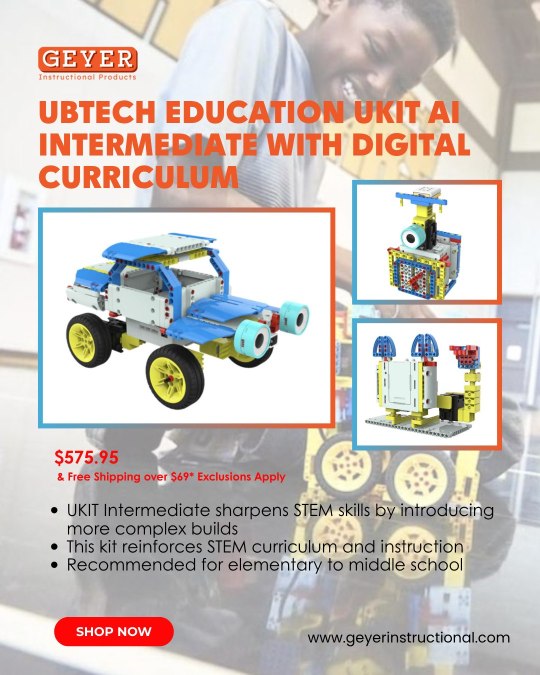
Perfect for beginner STEM programs, the UBTECH uKit AI Beginner Kit offers an immersive learning experience through robotics and artificial intelligence. The kit features a standards-aligned digital curriculum and hands-on building elements that promote problem-solving, critical thinking, and 21st-century tech skills. Ideal for classrooms, afterschool programs, or tech camps.
#STEMkits#ArtificialIntelligence#RoboticsEducation#FutureReadyLearning#TechInTheClassroom#UBTECHuKit#AIkitsForEducation#RoboticsInSchool#STEMcurriculum#STEM
0 notes
Text
How to Setup Robotics Lab in School – A Complete Guide to Establishing a Robotics Lab
In today’s technology-driven world, robotics education acts as an important asset in equipping students with 21st-century Robotics & AI skills such as critical thinking, problem-solving, and creativity. Robotics lab offers a dedicated space for students to engage in hands-on learning, exploring engineering, machine learning, and artificial intelligence (AI). By providing a well-structured Robotics & AI lab, schools generate our young learner’s interest in the field of STEM (Science, Technology, Engineering, and Mathematics), and make them ready for future careers in further Robotics & AI embedded technology. This will guide our learners in a direct approach to setting up a Robotics lab, and also ensure that students gain maximum educational benefits from this modern learning environment.
Defining Objectives and Goals
At the foundational stage of setting up Robotics & AI labs in schools, it is essential to clearly define the lab’s objectives and purpose. This helps schools determine whether the focus will be on basic robotics education, competition-driven learning, or innovation through patent-worthy projects. The primary goals include introducing our young learners to Robotics and AI, upgrading with programming and engineering skills, and preparing students for national and international tech. Competitions, and encourage them to become future innovators by learning the combination of innovative projects that combine balanced learning. These objectives will guide schools in planning the necessary resources such as designed curriculum and selecting appropriate equipment while learning the concept in Robotics & AI labs.
Securing Budget and Funding
Setting up robotics labs in schools involves a significant financial investment, and schools must plan their budgets accordingly. Several funding options are available in the authority, including school budget administration, government permits, corporate partnerships and sponsorship, and community fundraising initiatives. STEM education companies collaborate with the government for support with the education part and the material requirements according to the school for opening robotics & AI Labs in the school. At the same time, STEM education companies also offer sponsorship under several projects, provide teachers training programs by the STEM education companies, and Atal tinkering Labs handled by the robotics lab. CSR approach and alumni contributions can also give financial assistance.
Selecting the Right Space
Whenever a lab is established in a school, it is essential to carefully select a suitable space. Choosing the right location for the Robotics and AI lab is crucial to ensuring a practical, engaging, and productive learning environment. The lab should be spacious enough to have workstations, practical testing areas, robotics kits, and tool storage. It must also have proper ventilation, lighting, electrical connection, and internet connectivity. A well-setup layout with designated areas for programming, assembly, and testing enhances productivity and safety.
Procuring Robotics Kits and Equipment
Robotics Lab Selecting the right robotics kits and equipment is fundamental for creating an effective robotics lab. The selection of kits should be based on the learners’ age groups and their initial skill levels. For beginners, kits such as mechanical construction kits and block-based power screw kits are ideal. In terms of coding, platforms like Scratch and Code Blocks provide a built-in introduction to robotics and programming. Intermediate classes from 6th to 8th can benefit from Arduino, Raspberry Pi, and other robotics kits, which provide hands-on experience in coding and electronics technology. Students at the senior level can explore AI-powered coding platforms like AI Connect, Drone technology, and IoT-based machine learning projects. With all of this, the Robotics & AI lab will support various robotics innovations going to happen in the future.
Developing a Robotics Curriculum
A well-organized robotics curriculum ensures progressive growth in learning and development of new advanced skills. Schools should design the curriculum in such a way that it will cover all concepts from beginner to advanced levels, hands-on projects, and advanced robotics applications. In the beginner level from class 3rd to 5th class, learners will focus on basic robotics, easy-to-understand programming concepts, and understandable mechanical design. Then at the intermediate level for 6th to 8th class learners should focus on microcontrollers, robotics, and Machine learning robot programming. Later on at the advanced level, it should include AI, machine learning, IoT embedded, and participation in robotics competitions which motivates the students to do more innovation in the future.
Hiring Skilled Educators and Mentors
After setting up the lab, the most crucial person is the one who will run it – the ideal role model and mentor. This individual will guide our future learners towards a bright future, equipped with up-to-date knowledge in advanced technology and artificial intelligence. Our STEM companies provide STEM-certified educators, who are the best mentors to help students grasp the concepts of robotics and AI in an engaging and enjoyable way. They are essential for guiding students in this specific direction of gaining knowledge in robotics and AI. As per our advice, schools should recruit STEM-certified educators with expertise in all directions where they should be experts in their fields of Science, Technology, Engineering & Mathematics.
Robotics Lab in School Following that, it is important to establish collaborations with university researchers, industry professionals, and robotics organizations to provide students with valuable insights, real-world exposure, and expert mentorship. If some schools want to train their teachers for this subject, then our STEM education companies provide teachers training programs and organize workshops for the teachers to ensure that instructors remain updated with the latest technology in robotics technology. This also encourages students to a learning approach, where senior students can also mentor in the class and it also enhances engagement and knowledge-sharing skills.
Implementing Safety Measures
In the Robotics & AI lab, we need to ensure that we have proper safety for the students in the robotics lab. It is essential to establish clear guidelines on the Circular Board for handling electronic components and computer systems provided in the lab. Additionally, students must be trained in basic first aid procedures to ensure they are prepared to respond effectively in case of any mishap, emphasizing the importance of safety and preparedness in a lab environment. The essential safety measures include protective gear such as gloves and safety goggles, building fire safety protocols, and training students for first aid. These properly structured lab sessions with instructor supervision help to maintain a safe environment in the lab.
Conclusion
In conclusion, establishing Robotics & AI labs in schools marks a progressive leap in advancing STEM education and preparing students for a tech-driven future. A well-designed and thoughtfully planned lab—with clear objectives, suitable equipment, expert mentorship, and a structured curriculum for all grades—creates an engaging, future-ready learning environment. Getting educated about Robotics & AI education develops technical skills and also enhances creativity, teamwork, and critical thinking approach toward the problem and its solution. By continuously approaching & upgrading resources such as curriculum and student participation in the competition, schools can work hard to motivate the upcoming generation of young innovators and engineers who are ready to lead the vision of future innovators.
0 notes
Text
Combat Robotic Kits Market Expansion Driven by Innovation and Tactical Needs
It is anticipated that the global market for combat robotic kits will be valued at US$ 179.1 million in 2023 and grow at a compound annual growth rate (CAGR) of 10.4% to reach US$ 481.6 million by the end of 2033.
What Are Combat Robotic Kits—and Why the Hype?
Combat robotic kits are modular sets of components such as chassis, motors, batteries, armor plates, and drive systems. These kits allow users to build robots capable of engaging in battles in specially designed arenas. Popular categories include wedge bots, spinners, and drumbots, all competing to disable or outmaneuver opponents. These kits have gained popularity for offering a unique mix of creativity, competition, and learning, especially among students and hobbyists.
The surge in combat robotic interest can be attributed to growing participation in university-level tournaments and local leagues. North America and Europe have become primary hubs for these activities, thanks to strong educational support and widespread access to technical resources. Combat robotics events are often hosted by academic institutions, tech clubs, and televised competitions, which further amplify interest and market demand.
A Sports-Robotics Parallel
Combat robotics is part of a larger movement where robotics and sports intersect. As investments in robotics have surpassed hundreds of billions globally, the interest in accessible robotic entertainment has grown. Combat robotic kits serve as an entry point into this world, attracting young minds into STEM fields while offering them the thrill of competition.
Thanks to advancements in kit designs, many enthusiasts now find it easier to enter the field without prior engineering knowledge. Kits with plug-and-play modules, detailed instructions, and strong online communities have reduced the learning curve. This has led to a broad base of participants ranging from school students to seasoned engineers.
Growth By the Numbers
From 2018 to 2022, the combat robotic kits market grew at a CAGR of 7.1%. With the current growth trajectory, the market is expected to continue expanding at 10.4% CAGR through 2033. In 2023, North America led the global market with a 36.3% share, valued at approximately USD 64.9 million. Europe followed with a 28.1% share, contributing nearly USD 50.4 million to the global market. These two regions benefit from well-established educational frameworks and a culture of innovation.
Asia-Pacific, particularly East Asia and Oceania, is emerging as a new frontier for market expansion. With rising interest from China, Japan, and South Korea, along with supportive government policies for technology education, the region is poised for future growth.
Who’s Building These Bots?
The professional user segment dominates the combat robotic kits market. These users often build advanced robots featuring reinforced frames, high-torque motors, precision control systems, and sometimes even AI-based features. Such users typically participate in high-stakes competitions and invest in robust kits with advanced weapon systems.
Among various robot types, wedge bots are the most popular, holding a 25.7% market share. Their simple yet effective design makes them a favorite among beginners and pros alike. Spinners and drumbots are also gaining popularity for their offensive capabilities and unique engineering challenges.
Challenges on the Road to Combat
Despite impressive growth, the combat robotic kits market faces some hurdles. High costs associated with components, especially motors and armor materials, can deter new entrants. Many hobbyists may opt for pre-built robots instead of fully customizable kits due to the complexity and cost of customization.
Regulatory issues also present challenges. Combat robotics involves mechanical force, which can pose safety risks if not handled properly. Event organizers must implement strict guidelines around permissible materials, weight limits, and weapon types to ensure safety and fair competition. These rules, while necessary, can add complexity to the design and participation process.
Another challenge is the competition from off-the-shelf systems. Some users prefer purchasing ready-made robots that offer reliable performance, avoiding the learning curve and time investment of building from scratch.
Cutting‑Edge Innovation
Innovation continues to play a key role in market development. Leading manufacturers have introduced modular kits that allow for rapid customization and part swapping. Companies such as AdvanceTech, SparkFun, and Mikroelektronika offer versatile kits compatible with a wide range of sensors, controllers, and accessories.
Smart integration is another trend. Builders now incorporate sensors, cameras, and microcontrollers into their designs. This enables features like remote control, real-time diagnostics, and even basic forms of autonomous behavior. AI is gradually finding its place in combat robotics, allowing bots to make decisions during matches.
Localized production is also gaining momentum. Some manufacturers are entering regional partnerships to reduce delivery times and production costs, especially in emerging markets. This strategy not only makes the kits more accessible but also helps manufacturers build stronger community ties.
Combating Expenses and Customization
To overcome cost and complexity issues, manufacturers are focusing on advanced yet affordable materials. Composite and ceramic components enhance durability while keeping costs in check. Modular designs are being developed for quick assembly and repair, improving the user experience and lowering long-term costs.
Sensor integration is also improving. Wireless temperature, vibration, and current sensors can now monitor robot health, helping users perform preventive maintenance. These features, once seen only in industrial machines, are now part of consumer-level combat kits.
Manufacturers are also adopting environmentally friendly practices, including recyclable packaging and responsibly sourced components. As awareness about sustainability increases, these practices are likely to become industry standards.
The Road Ahead
The future of the combat robotic kits market looks promising. With projections placing its value at USD 481.6 million by 2033, it’s clear that this niche hobby is turning into a global trend. North America and Europe will likely maintain leadership positions, but rapid development is expected across Asia, Latin America, and the Middle East.
Key growth drivers include educational initiatives that integrate robotics into school and college curricula, especially in STEM fields. Hybrid competition formats that blend sport and tech demonstrations are gaining popularity, attracting corporate sponsorship and media coverage.
AI and autonomy will play a bigger role in the coming years. Robots with built-in intelligence will open new competitive possibilities, changing how builders strategize and compete. Customization ecosystems are also expanding, with third-party developers offering everything from chassis parts to specialized software.
What Builders Should Keep in Mind
Aspiring builders should keep a few things in mind. Budgeting is critical—what starts as an affordable hobby can quickly become costly with upgrades and replacements. Understanding competition rules is also important, as every event may have unique guidelines regarding weight, weapon types, and materials.
Testing is essential. Always run trial matches in safe environments to identify design flaws or safety issues. Connecting with local clubs and online communities can offer invaluable support, troubleshooting tips, and upgrade ideas.
Choosing modular kits can save time and money in the long run. These kits offer flexibility and scalability, allowing users to update or rebuild without starting from scratch.
0 notes